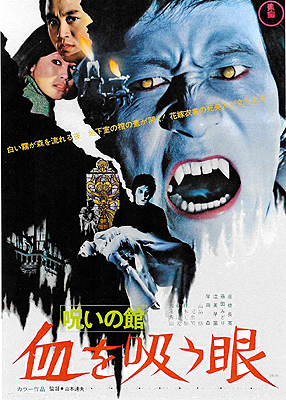 Lake of Dracula / Dracula’s Lust for Blood / Bloodthirsty Eyes / Noroi no Yakata: Chi o Suu Me (1971/1973) ***
Lake of Dracula / Dracula’s Lust for Blood / Bloodthirsty Eyes / Noroi no Yakata: Chi o Suu Me (1971/1973) ***
I still don’t get why no American distributor saw any value in The Vampire Doll, but I do see why Lake of Dracula, the first of that movie’s spiritual successors, was deemed a slightly better risk in the US market— good enough for television and home video, anyway. It’s a tighter, more coherent film, which plays by more of the usual rules for the vampire subgenre. At the same time, though, it carries over its predecessor’s painterly visual sensibility, owing equal amounts to Hammer Film Productions, the American International Pictures Poe cycle, and the 1960’s gothics of Mario Bava and Ricardo Freda. And the kinds of scares it delivers are closer to what audiences trained on those movies will be expecting. None of that, however, adds up to Lake of Dracula being a better film, because it sacrifices in exchange the unsettling dreaminess that was The Vampire Doll’s most appealing and effective quality.
When Akiko Kashiwagi (Midori Fujita) was six years old, she had a terrifying nightmare. She dreamed that she was playing on a stony beach with some other children and her pet dog, Leo, when she lost her grip on the leash, and the animal ran away down a nearby tidal cave. Akiko followed, eventually emerging in a forest surrounding a strange house built in the manner of a European chateau. The door was unlocked, and she went inside— where she was confronted by a white-clad dead woman sitting at a piano, and a lanky man (Shin Kishida, from Godzilla vs. the Cosmic Monster and Lady Snowblood 2: Love Song of Vengeance) with sharp teeth and inhuman, golden eyes. Those eyes in particular have haunted Akiko ever since, to the point that they’ve become a recurring motif in the paintings that supplement her income as a schoolteacher.
They must supplement it a lot, too. Although Akiko lives only with her younger sister, Natsuko (Sanae Emi, of Mini-Mini Shock Troops), who has no discernable occupation, she’s able to afford a big, sturdy, Western-style villa overlooking the shores of Lake Fujimi, a legitimately lovely tourist trap near the conjoined metropolises of Tsugaru and Goshogawara in the far north of Hosho. She’s romantically successful as well, dating Takashi Saeki (Choei Takahashi, from Fugitive Alien and Sweet Scent of Eros), an ER doctor at one of those cities’ municipal hospitals. The latter relationship is a bit of a sore point between Akiko and her sister, however, because Natsuko has a thing for the doc herself.
Anyway, one morning, when Akiko goes down to the lake to work on her latest surreally eerie canvas, she witnesses the start of something even eerier. She’s interrupted while chatting with Kyusaku (Kaku Takashima, returning from The Vampire Doll), the handyman at the lakeside inn, by the arrival of a shifty-looking trucker (Portrait of Hell’s Tadao Futami) bearing a huge and heavy crate. Kyusaku wasn’t expecting any deliveries at all today, let alone something like this, and the driver is stubbornly tight-lipped about where he came from, whom he works for, and what’s supposed to be in the crate. Akiko goes her way, leaving the handyman to give this sudden nuisance his full attention. It truly is a nuisance, too— from the size and shape of the crate, you’d think there was a coffin inside! In fact, that’s exactly what Kyusaku finds when he pries open the box. There’s no corpse, at least, but there is a worrisome red stain on the satin lining, about where the head would be if the coffin were occupied. And get this— the shipping ticket identifies the sender as “Dracula.” The customer service rep for the Nishihara Trucking Company is no more helpful than the driver was when Kyusaku calls to protest what he assumes is some kind of grotesque prank, and that fruitless phone conversation consumes what remains of the hours of daylight. That’s when the coffin’s owner comes calling. He presumably isn’t literally Dracula, but he is a vampire. And what’s more, he’s the one from Akiko’s dream all those years ago. The vampire bites Kyusaku, stopping short of killing or turning him undead, but taking just enough blood to madden and enslave him.
It takes nearly 24 hours for that to become Akiko’s problem. She spends the following day in the city with Natsuko, concluding by making plans for the two of them to meet Takashi for dinner out after his shift at the hospital. Those plans get scuppered very quickly, though, when a girl (Evil of Dracula’s Miko Katsuragi) is brought in suffering from severe blood loss despite exhibiting no injuries sufficient to account for it. In fact, her only wounds are a pair of small punctures on the side of her neck. Heaven knows when Takashi will be able to leave work now, so the sisters head back to Akiko’s house. Once there, they discover that Akiko’s dog (which happens to be named Leo, just like the one she had when she was five) has broken his tether and run off. Akiko goes looking for him in the surrounding woods, and is horrified to discover his dead body in a patch of tall grass just past the treeline on the other side. A still bigger shock comes just moments later, when Kyusaku approaches her from behind, his strange demeanor leaving little question but that he killed the dog. Then Kyusaku attacks Akiko— and although she will later tell Natsuko that he tried to rape her, it’s obvious to us at this point that his true intention is to hand her over to the vampire come sundown. Akiko is just lucky that a pair of fishermen (Yasuzo Ogawa and Wataru Omae, who played similarly minor roles in The H-Man and Latitude Zero respectively) inadvertently rescue her by stopping by the inn to borrow a boat mere moments before the undead fiend can claim his prize. Kyusaku and vampire alike make themselves scarce, however, so that there’s no sign of either when the men search the inn at Akiko’s instigation. Even then, the artist’s evening of terror isn’t at an end, because now Natsuko has gone missing. Akiko is in the midst of phoning Takashi for help when her sister returns, saying that she’d simply gone for a walk around the lake. But that story doesn’t quite add up, does it? Why didn’t Natsuko come looking for Akiko hours earlier, when she disappeared searching for Leo? How can she so blithely dismiss her sister’s account of her travails in the woods and at the inn? And where did Kyusaku and the vampire go when they fled discovery by the fishermen? Do you suppose we’d see another pair of little puncture wounds if Natsuko took off that kerchief she has tied around her neck? Sure enough, when something awakens Akiko in the middle of the night, she spots her sister from the window at the edge of the woods, tarrying with a black-clad man whom she feels as though she recognizes, even though she has no conscious memory of having ever seen him before.
Meanwhile, at the hospital, Takashi and the staff have been able to identify their exsanguinated patient as the runaway daughter of a local farmer. She seems to have no memory of what happened to her, but she was seen hitchhiking the night before on the road that passes by Lake Fujimi— the same road where she was found this afternoon. Despite her precarious condition, the blood-drained girl gets up late that night, and tries to flee the hospital; the night-shift security guard’s efforts to restrain her result only in her taking a fatal header off the top-floor fire escape. So Takashi is already in a mood receptive to signs of weirdness when he swings by the Kashiwagi house after work to make sure everything’s really alright, and finds the two sisters squabbling with inexplicable acrimony over whether or not Natsuko went out to meet a man in the woods at 0-dark-30 that morning. On the other hand, the doctor doesn’t seem to notice how much paler the younger woman has become since the last time they met, so maybe he wasn’t so sensitized to abnormality after all. (Saeki doesn’t seem to notice Natsuko’s Significant Turtleneck, either, but that’s forgivable since this is Japan in the early 1970’s. Just fucking turtlenecks as far as the eye could see…) Now it happens that this is Takashi’s day off, so he plans on sticking around after he’s had some sleep. That will put him directly in the line of fire the following night, when the vampire— aided by both Natsuko and Kyusaku— springs a trap designed to add Akiko to his growing harem. On the upside, it will also put Takashi in as good a position as anyone can be to thwart the bloodsucker’s plan, and it will present him with the kind of evidence that would make just about anyone believe in vampires. When Takashi and Akiko escape to the hospital to plot their next move, the doctor also makes the connection that has thus far eluded his beleaguered girlfriend: maybe that haunting childhood nightmare of hers was no dream at all. Maybe she and the vampire had already met once before. And if that’s true, then maybe hypnosis will enable them to extract from her half-buried memories the key to an effective counterattack.
If you objected to The Vampire Doll’s Italian gothic approach to story construction, you will probably find Lake of Dracula a considerable improvement. If, on the other hand, that irrational streak was your favorite thing about the earlier film, you will probably find this one disappointing. Of the three major Western influences on the Bloodthirsty Trilogy that I cited earlier, the Italian is noticeably the weakest this time around, outside of the purely visual aspect, while the Hammer vibe is correspondingly strengthened. I appreciate Ricardo Freda and Terrence Fisher about equally, though, so for me, the shift amounts to six of one and half a dozen of the other. Meanwhile, the tension between producer Fumio Tanaka, who wanted gothic horror pictures in a contemporary setting, and director Michio Yamamoto, who would rather have made Hitchcockian conspiracy thrillers instead, has been resolved decisively in Tanaka’s favor. That does wonders for Lake of Dracula’s clarity of purpose, but it robs the film of the capacity for total surprise that the two men’s fundamental disagreement imparted to The Vampire Doll. One thing Lake of Dracula will unfortunately never give you is a sharp zig when you’re expecting a zag.
The good news is that Yamamoto did a much better job here of updating a Hammer premise to a modern setting than Hammer themselves would ever manage. In that respect, the Western film that Lake of Dracula resembles most closely is Count Yorga, Vampire. Shin Kishida is a serviceable enough master vampire, although the various undead women, with their eerie combination of lethality and childlike beauty, are all scarier than he is. The golden-eye effect for the vampires remains as freaksome as it was in The Vampire Doll, so that it’s no wonder Toho called attention to it in the original Japanese title (which means Cursed Mansion: Bloodthirsty Eyes). The final act incorporates interesting echoes of The Brides of Dracula after the vampire’s father (Hideji Otaki, from Zatoichi in Desperation and Lone Wolf and Cub: Baby Cart in the Land of Demons) enters the story, reminding us that Japan, too, experienced a generational crisis in the 1960’s. All in all, Lake of Dracula is a solid, successful effort to translate Western horror concepts into the Japanese milieu, and like its predecessor, it deserves more international attention than it received in its day.
Home Alphabetical Index Chronological Index Contact

